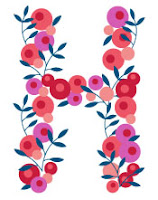 Here is what I love: Jane Austen, tea parties, Jane Austen themed tea parties, Anthropologie window displays, traveling, Cavelier King Charles Spaniels, and.......Liberty of London. Pardon the title's anti-patriotic play on words -- Patrick Henry is rolling in his grave right now. My first encounter with Liberty came during my first real trip abroad to England when I was a wee precocious ten year old, and it is to this family vacation that I blame my obsessive adoration for all things British. During our tour of London ("tour" being used in a loose sense, if you consider my dad shuffling us around with his Rick Steve's guide, fanny pack, and zip-off pants a proper "tour"), in between the Tower of London and afternoon tea at Brown's, my mother and I hit up all the classic department stores, including Harrod's and Liberty. It was at Liberty that I truly fell in love: from it's spectacular Tudor facade to the miles and miles of beautiful prints inside.
Here is what I love: Jane Austen, tea parties, Jane Austen themed tea parties, Anthropologie window displays, traveling, Cavelier King Charles Spaniels, and.......Liberty of London. Pardon the title's anti-patriotic play on words -- Patrick Henry is rolling in his grave right now. My first encounter with Liberty came during my first real trip abroad to England when I was a wee precocious ten year old, and it is to this family vacation that I blame my obsessive adoration for all things British. During our tour of London ("tour" being used in a loose sense, if you consider my dad shuffling us around with his Rick Steve's guide, fanny pack, and zip-off pants a proper "tour"), in between the Tower of London and afternoon tea at Brown's, my mother and I hit up all the classic department stores, including Harrod's and Liberty. It was at Liberty that I truly fell in love: from it's spectacular Tudor facade to the miles and miles of beautiful prints inside. To me, Liberty embodies British chic. Established by Arthur Liberty during the Victorian Era in 1875, the iconic British department store introduced Eastern textiles and other goods to the West and soon became synonymous with bold floral prints and decorative patterns. In this video, Liberty's creative director, Tamara Salman, talks about the history of Liberty, as well as the company's design process.
For this Drop Cap, I recreated one of Liberty's classic floral prints into the shape of an H.


















 Relax. I only said "cannibals" because this post comes to you via my 18th Century British Novel class, for which I just finished reading Daniel Defoe's famous adventure story, Robinson Crusoe. The reason this fits within the History of Visual Communication is not just because I am an 18th century British novel fiend, but because my Oxford Edition of the book features the title page from the original 1719 published novel which yes, is relevant to our little discussion. It even has the old English spelling, with the lowercase "s" that looked like an "f", and the Germanic capitalization of nouns. Sorry to get all grammar crazy on you (
Relax. I only said "cannibals" because this post comes to you via my 18th Century British Novel class, for which I just finished reading Daniel Defoe's famous adventure story, Robinson Crusoe. The reason this fits within the History of Visual Communication is not just because I am an 18th century British novel fiend, but because my Oxford Edition of the book features the title page from the original 1719 published novel which yes, is relevant to our little discussion. It even has the old English spelling, with the lowercase "s" that looked like an "f", and the Germanic capitalization of nouns. Sorry to get all grammar crazy on you (